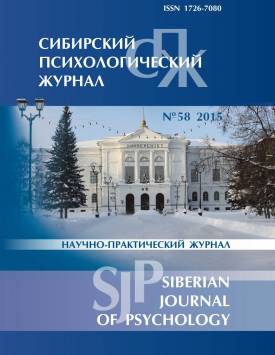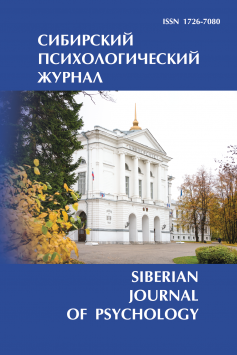The creative leadership: transcultural prospect
Development of innovative activity and entrepreneurship in the modern conditions poses new questions and opens prospects for a rethinking of traditional problems of leadership. Based on recent psychosemantic studies of some leading entrepreneurs their distinctive characteristics were identified: considerably expressed conceptualization of the main and key psychosemantic communicative worlds: "I am as a leader" and "Members of my team". The intensity of conceptualization was understood as expressiveness among the leaders of conceptual assimilation of burning problems and contradictions. The second difference consists in a more expressed decentration of psychosemantic focus of attention of the leaders to the world of "Members of my team". Article is devoted to the formation and the proof of a hypothesis of the communicative and conceptual nature of creative leadership and opportunities of its development in the conditions of university education. The concept of creative leadership comes to light through the analysis of historical transformation of ideas of a superleadership phenomenon. In the long term developments of the concept of "superleadership", a concept of "creative leadership" is considered as a breakthrough project and a new transcultural metaposition and metaprospect in development of a new psychological environment for creative groups as an opportunity to overcome the chronic presence of traditional concepts of leadership at textbooks which stopped being relevant to modern living conditions. Creative leadership is understood as an authentic communication as primary creativity and coauthorship of a leader with his employees. Employees thus gradually and naturally become co-leaders of a unified creative process in finding solutions for innovative tasks. The concept of creative leadership organically incorporates the classical scheme of creative process by G. Wallace and the modern multidimensional typological model of a creative person by O. Kreger and D. Goldstein based on psychological typology and a method Myers -Briggs (MBTI). The conceptual scheme of creative leadership is specified by means of the Model of escalation of achievements of a creative person developed by us earlier. It has a four-dimensional structure including stress-mobilization when encountering the Unknown, reorientation on the basis of search activity and immersion in the New, transformation of a position due to new discovered solutions and development of a new way of life in a new position and form. At this stress-trance-formation a creative leader shares risks of transformation and responsibility with participants who become his creative co-leaders. It results in a high-quality transformation of the psychological and creatively oriented environment of the team working on a breakthrough project. The article also presents the experience of formation of such abilities and competences of Master's program graduates at Tomsk state university.
Keywords
креативное лидерство,
суперлидерство,
креативный процесс,
децентрация,
концептуализация,
креативная среда,
creative leadership,
superleadership,
creative process,
decentration,
conceptualization,
creative environmentAuthors
| Kabrin Valery I. | Tomsk State University | kabrin@list.ru |
Всего: 1
References
Кабрин В.И., Сметанова Ю.В., Звездина Е.А. Пилотное исследование транскультуральной психосемантики личностно значимых коммуникативных миров инновационно- и предпринимательски ориентированной молодежи // Вестник Томского государственного университета. 2015. № 394. C. 211-219.
Кабрин В.И., Сметанова Ю.В., Звездина Е.А. Сравнительное исследование психосе мантики тенденций развития предпринимательства в сибирском регионе в транс-культуральном контексте // Вестник Томского государственного университета. 2015. № 400.
Акофф Р., Гринберг Д. Преобразование образования. Томск : Издательство Томского государственного университета, 2009. 196 с.
Малоун Т. Ключевые способности для распределенного лидерства. URL: http://www.elitarium.ru/2009/12/25/raspredelennoje_liderstvo.html
Malone T. W., Laubacher R., Morton M. Inventing the Organizations of the 21st Century. Cambridge, MA : MIT Press, 2003. 456 p.
Маслоу А. Новые рубежи человеческой природы. М. : Альпина Нон-фикшн, 2011. 496 с.
Роджерс К. Становление личности : Взгляд на психотерапию. М. : Эксмо-Пресс, 2001. 415 с.
Чиксентмихайи М. Поток: Психология оптимальных переживаний. М. : Смысл: Аль пина нон-фикш, 2013. 461 с.
Селигман М. Путь к процветанию: Новое понимание счастья и благополучия. М. : Манн, Иванов и Фарбер, 2013. 440 с.
Кабрин В.И. Транскоммуникабельность ценностно-смысловых концептов и когни тивно-конструктивных решений творческой личности (введение в ноэтический ан-тропопоэзис) // Сибирский психологический журнал. 2014. № 54. С. 158-176.
Сурина Т.В. Поэзис как архетип культуры // Вестник Томского государственного университета. 2008. № 316. С. 67-70.
Бендас Т.В. Психология лидерства. СПб. : Питер, 2009. 448 с.
Klagge J. Defining, discovering and developing personal leadership in organizations // Leadership and organization development journal. 1996. Vol. 17, № 5. P. 38-45.
Кудряшова Е.В. Лидерство как предмет социально-философского анализа : дис.. д-ра филос. наук. М., 1996. 359 с.
Lloyd B. A new approach to leadership // Leadership and organizational development journal. 1996. Vol. 17, № 7. P. 29-32.
Manz C., Sims H. Leading Workers to Lead Themselves: The Eternal Leadership of Selfmanaged Work Teams // Administrative Science Quarterly. 1987. № 32.
Ассаджиоли Р. Психосинтез: принципы и техники. М. : Психотерапия, 2008. 384 с.
Юнг К.Г. Структура психики и архетипы. М. : Академический проект, 2013. 328 с.
Кабрин В.И. Транскоммуникация и личностное развитие. Томск : Изд-во Том. ун-та, 1992. 256 с.
Кабрин В.И. Коммуникативный мир и транскоммуникативный потенциал жизни личности: теория, методы, исследования. М. : Смысл, 2005. 248 с.
МикалкоМ. Креативный взрыв. Минск : Попурри, 2014. 256 с.
Налимов В.В. Спонтанность сознания: Вероятностная теория смыслов и смысловая архитектоника личности. М. : Академический проект: Парадигма, 2011. 399 с.
Любарт Т. Психология креативности. М. : Когито-Центр, 2013. 215 с.
Крегер О., Тьюсон Дж. Типы людей: 16 типов личности, определяющих, как мы живем, работаем и любим. М. : Персей: Вече, АСТ. 544 с.
Крегер О., Годстайн Д. Творческая личность: как использовать сильные стороны своего характера для развития креативности. М. : Манн, Иванов и Фербер, 2014. 416 с.
Кабрин В.И. Антропоцентрическая или ноэтическая эмердженция сознания // Си бирский психологический журнал. 2013. № 50. С. 17-37.
Мерфи М. Будущее тела: Исследование дальнейшей эволюции человека. М. : РИ- ПОЛ классик, 2010. 912 с.
Гроф Ст. За пределами мозга. М. : Изд-во Трансперсонального института, 2005.504 с.
Wilber K. Integral psychology: consciousness, spirit, psychology, therapy. Boston and London : Shambhala, 2000. 386 p.
Мэй Р. Мужество творить: Очерк психологии творчества. М. : Институт общегума нитарных исследований, 2012. 160 с.
Кабрин В.И. Комплекс психологических практик развития психологического потен циала достижений личности. Томск : Изд-во Том. ун-та, 2011. 116 с.
Луиджи З. Созидание души. М. : ПЕР СЭ, 2004. 205 с.
Апэлгейт Л. Прорывные инновации, или Использование дестабилизирующих факторов себе во благо. URL: http://hbswk.hbs.edu
Финкельштейн С., Лотон Т., Харви Ч. Стратегия прорыва. М. : Companion Group, 2007. 336 с.
Буш Г. Диалогика и творчество. Рига : АВОТС, 1985. 318 с.
Роджерс Н. Творческая связь: Исцеляющая сила экспрессивных искусств. М. : Манн, Иванов и Фербер, 2015. 336 с.
Поддьяков А.Н. Компликология: Создание развивающих, диагностирующих и де структивных трудностей. М. : Дом Высшей школы экономики, 2014. 278 с.

